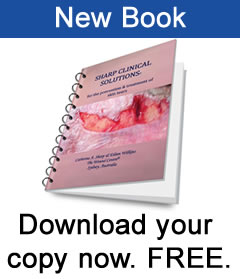Wound Dressings for the Frail Aged
I personally use, and recommend, ONLY silicone dressings i.e.Mepilex Border™ by Mölnlycke, and Allevyn Gentle Border™ by Smith & Nephew. Both dressings have a wonderful silicone adherent that holds the dressing in place very well but will not damage skin on removal.
The silicone dressings can be left on for a week (depending on the exudates) and I have used it on skin tears, lower limb ulcers and pressure ulcers in nursing home residents.
But how many times have I heard nurses, managers and even wound care colleagues say those dreaded words…Oh! That’s too expensive…when I tell them about the wonderful properties of these, and other, second and third generation wound dressings?
So to help you understand the actual cost of [doing] dressings, I have prepared a spreadsheet. Click here to see it. (you will need Excel on your computer to open it).
The left hand column shows the cost of a traditional daily wound-dressing regime using a dressing pack, impregnated gauze and a secondary dressing held in place with tape.
The right hand column shows the cost of a weekly dressing like Mepilex Border ™ applied immediately after a shower.
Click here for a Step by Step ‘How to Incorporate Your Wound Management into the Residents Shower Regime” (This chart can be printed out and used in your health care facility).
The objective of showering is to clean the wound and surrounding skin. Showering offers a cheap and easy option of copious amounts of water to clean the wound, far more than you would use with a dressing pack and a little pack of normal saline.
Often dressings that are ‘low adherent’ do STICK like glue to wounds! They are painful to remove, can tear the epidermis away from the dermis and create a much larger wound.
Tape used to secure dressings is often contaminated with microorganisms, including methicillin resistant Staphylococcus aureus (MRSA). Tape goes from patient to patient and lives in the fluffy pockets of nurses, around their necks with a bunch of keys and / or it gets thrown back into the cupboard to contaminate all the clean rolls of tape! Scissors used to cut tape may be contaminated with bacteria as well.
These are big infection control issues that are simple to address by just using an ‘all-in-one’ dressing….no tape, no scissors!
In particular for the elderly with their frail tissue paper skin, please think about silicone dressings, it will save their skin at the same time saving you money.
Tinea Pedis & Lower Limb Cellulitis
Did you know that tinea can be spread to many parts of the body eg. the groin, under an abdominal apron and in fingernails. All of this has me questioning the way I was taught to wash and dry patients, whether in bed or in the shower…top to bottom – face before genitals and feet. That makes sense? But what if we are spreading tinea from under the abdominal apron down to the genitals and feet!!
When somebody has tinea pedis (feet) the skin integrity is disturbed allowing bacteria such as Streptococci and Staphylococci to enter, and it is these bacteria that can cause cellulitis. If the tinea is not treated patients may present again and again with lower limb cellulitis. So it is a good idea to check for tinea pedis and treat it, if indeed it is present.
As we don’t always know who has tinea, the elderly, diabetics, and even healthy young athletes, it is time to rethink the whole process.
HiCare bath cloths, warmed in a microwave and disposed of after use…a fresh one for each part of the body. No towels, no wet sheets when bed bathing…that could save on laundry bills.
From an OH&S point of view, HiCare bath cloths would put a stop to the need for bowls of water to be carried to and from the bedside, thus reducing the risk of back injuries. Besides a bowl of water could literally be a bacteria soup – a real infection control issue!
Just by changing the simple practice of bedbathing / showering patients we could see a reduction in tinea and a concomitant reduction in the number of patients presenting with cellulitis of the lower limbs!
A tip to keep sacral hydrocolloids in place.
For years nurses have complained about the sacral hydrocolloids ‘rolling up’ and having to be changed. They may be rolling up because the edge of the dressing has stuck to the draw sheet or the patients’ gown or pyjamas. They stick to some fabrics because the edge of the hydrocolloid dressing is tacky and does tend to pull, or crinkle and roll up. I think most manufacturers’ have, of course, attempted to rectify this by making borders that are much thinner than the centre part of the dressing. Therefore the tacky surface is thinner too.
But once the dressing has rolled up you really must change it. This can be an expensive and unnecessary exercise especially when hydrocolloid dressings are designed to stay on for several days.
A tip to save you $$$’s!
I’m sure you all know that the warmth of your hands will help a hydrocolloid dressing adhere to the patients skin. Once the dressing is applied you need to press all over the hydrocolloid, gently with the palms of your hands, for several minutes.
Now that the hydrocolloid is firmly adherent to the patients skin, you can stop it sticking to the sheets or pyjamas by smearing some moisturiser or talcum powder (just a fingertip full) all around the edge of the dressing. This will take away that sticky edge completely.
This is just one of many little wound care tips I have learnt over the years. A great inspiration and source of knowledge for me, has come from members of the Wound Care Association of New South Wales (WCANSW) Inc. For those of you who live in Australia it is easy to phone committee members if you need advice or want to join the Association. For those of you who live overseas you can email any of the committee or when you visit Australia one day you could tie your holiday in with a conference!! Log on to the WCANSW Inc. website and find out more!
Pressure Ulcers: repositioning and staging
I believe most healthcare workers know that unrelieved pressure over any part of the body for a period of time can result in pressure ulcers. But do pressure ulcers always start on the surface of the skin and work through fat and muscle to the bone? Or is it possible that pressure damage starts at the bone and works outwards to the skin…meaning that you can’t actually see the damage until it is too late. Is a Stage I pressure ulcer actually an ulcer or is it just a sign that the patient is at risk? Is it possible for pressure ulcers to start anywhere between skin and bone, the mattress, fat and muscle. We can’t be sure because we cannot ’see’ inside the tissues — we can only imagine.
And how do you prevent pressure ulcers? Are you still repositioning patients every two hours (or three or four?) Perhaps some of your patients don’t get repositioned at all on a busy shift.
You may be fortunate to have alternating pressure air mattresses (APAM) and chair cushions that will relieve pressure to all parts of the body, every few minutes, for all your patients. That really does help!
There is so much to read on this fascinating subject but I bet you, like me, just don’t have time to search all the literature for the right information. And how do you know what is right? Well you can reduce your reading time from hours to minutes each week and still learn lots about pressure ulcers…real common sense information! Because all it takes to prevent pressure ulcers is common sense. It really is a very simple concept described in a paper that will open a window into this intriguing topic.
WHAT’S THE PAPER?
‘A discourse on pressure ulcer physiology: the implications of repositioning and staging’
by Sharp & McLaws October 2005
WHERE DO I FIND THIS?
Just go to the World Wide Wounds site and you can download the paper for free: www.worldwidewounds.com
Or Click on this link to go directly to the paper
A discourse on pressure ulcer physiology: the implications of repositioning and staging by CA Sharp, M-L McLaws
I trust it will give you answers but what I hope it will do more than anything is provoke great debate in your wound care groups and with your colleagues.
Hydrocolloid Dressings & Caterpillar Spikes
I just love Sydney in the summertime! I bet you find summer glorious too, no matter which hemisphere you live in right now. It is a perfect time to go bare-foot everywhere. But often times hidden in the grass, basking in the sun, are furry, stinging caterpillars which, when stood on, detonate hundreds of tiny spikes into the sole of your foot. This stops you dead in your tracks because it is not only excruciatingly painful but the spikes make it impossible to walk.
You can pick the spikes out one at a time with tweezers but this can take forever and the pain is still searing!
One really easy way to reduce the pain and remove all those stinging furry spikes at the same time is to stick a hydrocolloid dressing over the sole of the foot. Make sure you cover the spiked area, with a good margin around – say 3-4 cms., and lay back and relax for a while, allowing your body heat (and/or sun) to soften the hydrocolloid dressing. The dressing will adhere firmly to the spikes and the soles of your feet. For best results leave on as long as practical… overnight is good; two to four days is better.
When you peel off the hydrocolloid, which may well have turned into a gluggy, sticky, jelly and custard-looking substance all the spikes should be embedded in the hydrocolloid!! Wash your feet – you can repeat the process if spikes still remain in the skin – and remember to wear thongs or sandals.
Why not pass this on to your colleagues working in emergency departments. You can use this process for other areas of the body that get spiked too.


